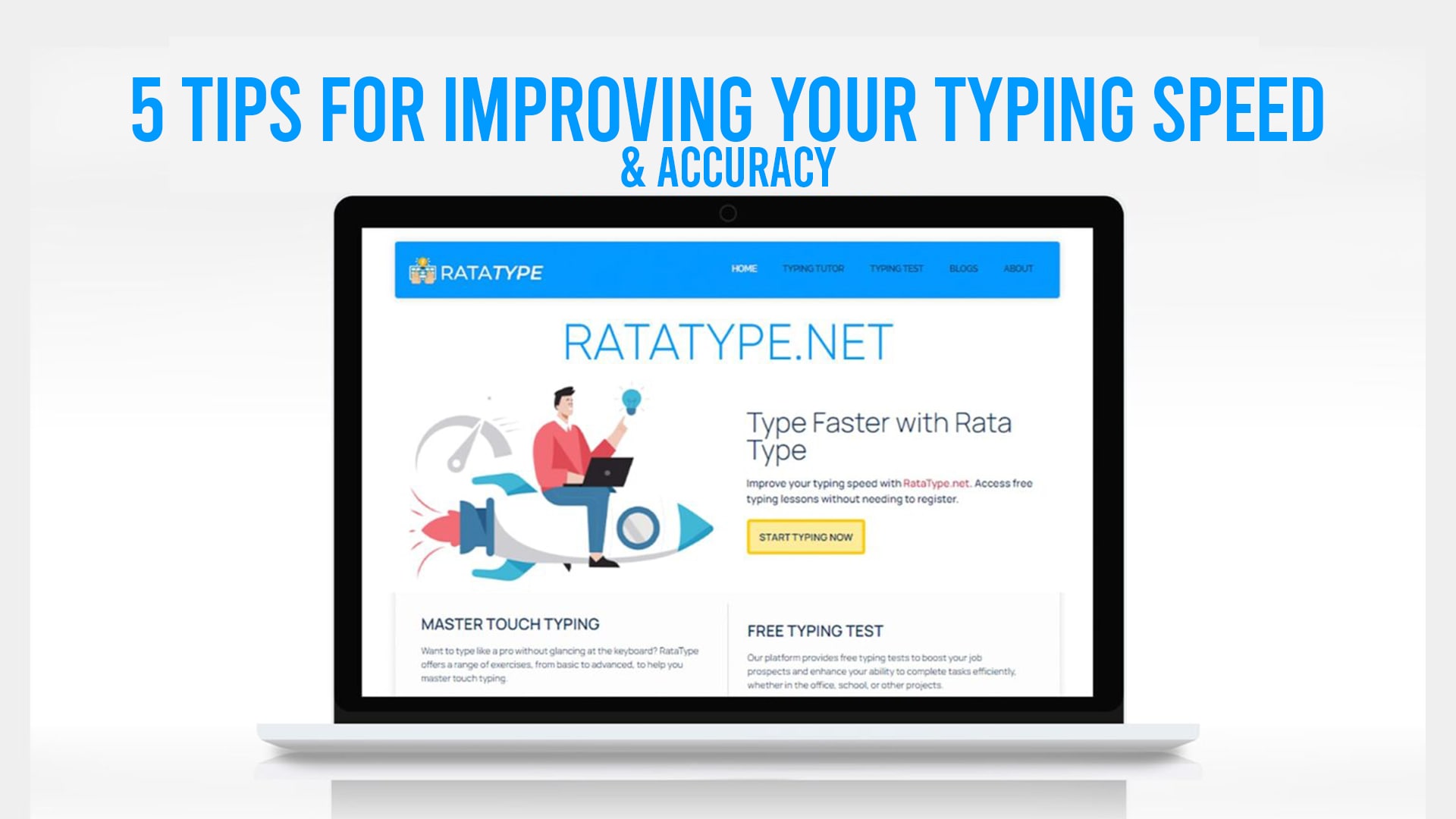In today’s fast-paced digital world, typing quickly and correctly is a key skill. Whether you’re writing emails, working on assignments, chatting with friends, or applying for a job, your typing speed and accuracy matter a lot. The faster and more accurate you are, the more productive and confident you’ll become.
But not everyone starts as a master typist. Many people struggle with slow typing speeds or frequent errors. The good news? You can improve both your speed and accuracy with a few practical steps.
In this article, we will share 5 proven tips to help you type faster and with fewer mistakes. These tips are simple, effective, and perfect for beginners or anyone looking to sharpen their typing skills. Plus, if you want to test your progress and even earn a free typing certificate without registration, Ratatype is a great place to start.
Master the 10-Finger Typing Method
The first and most important tip for improving your typing skills is to learn 10-finger typing. It’s the foundation of fast and accurate typing. Instead of using just a few fingers or looking at the keyboard, 10-finger typing helps you type smoothly with all your fingers.
What Is 10-Finger Typing?
10-finger typing is a method where each finger is responsible for certain keys. Your fingers rest on the “home row” (ASDF for the left hand and JKL; for the right hand) and move up or down to reach other keys. Your thumbs control the space bar.
Why It’s Important:
Helps you type without looking at the keyboard.
Boosts speed as all fingers work together.
Reduces errors by improving muscle memory.
How to Learn:
Practice daily on typing websites like Ratatype, which offer lessons specifically for 10-finger typing.
Focus on finger placement and stay consistent.
Avoid bad habits like “hunt and peck” typing.
Pro Tip:
In the beginning, don’t worry about speed. Focus on learning the correct finger positions first. Speed will naturally improve as your fingers memorize the keys.
Practice with Purpose and Consistency
Typing is like any other skill — you need regular practice to get better. But don’t just type randomly. Make your practice sessions purposeful and consistent.
What Is Purposeful Practice?
It means focusing on specific typing goals — for example:
Improving your WPM (Words Per Minute)
Reducing your typing errors
Getting better at tricky keys like numbers and punctuation
How to Practice Effectively:
Use structured typing lessons on platforms like Ratatype.
Set daily or weekly goals for speed and accuracy.
Start with short typing exercises and gradually increase the time.
Recommended Practice Duration:
15 to 30 minutes a day is ideal for beginners.
Advanced users can practice for 45 to 60 minutes.
Monitor Your Progress:
Ratatype provides free typing tests that give detailed feedback on your WPM and accuracy. You can even earn a certificate without signing up — a great motivation to keep improving.
Focus on Accuracy Before Speed
Many people think typing fast is the goal, but typing correctly is even more important. High speed with lots of mistakes doesn’t help you in the real world. You’ll spend more time fixing errors than doing actual work.
Why Accuracy Matters:
Reduces time spent on corrections
Builds better typing habits
Makes you more confident and professional
How to Improve Accuracy:
Slow down! Focus on typing each word correctly.
Don’t rush — your speed will increase over time.
Keep your eyes on the screen, not the keyboard.
Use backspace only when necessary; try to avoid errors instead of constantly fixing them.
Use Tools to Track Accuracy:
Ratatype’s typing tests show your accuracy percentage. Aim for at least 95% accuracy before focusing on speed.
Create a Comfortable Typing Environment
Your typing environment plays a big role in your performance. If your posture is wrong or your keyboard is uncomfortable, it can slow you down and even cause strain or injury.
Tips for an Ideal Typing Setup:
🪑 Posture
Sit up straight with your back supported.
Keep your feet flat on the floor.
Keep your elbows bent at 90 degrees.
⌨️ Keyboard & Desk
Use a keyboard with soft, responsive keys.
Place the keyboard at a height where your wrists stay straight.
Use a wrist rest if needed.
🖥️ Monitor Position
Keep your monitor at eye level to avoid neck strain.
Avoid tilting your head down for long periods.
🧘 Take Breaks
Take a 5-minute break every 30 minutes.
Stretch your fingers, wrists, and neck.
Why It Helps:
Reduces fatigue and discomfort
Increases focus and typing consistency
Prevents long-term injury like carpal tunnel syndrome
Use Typing Games & Tests to Stay Motivated
Typing practice doesn’t have to be boring. Fun and interactive tools can keep you engaged while improving your skills. Typing games are a great way to build speed and accuracy without even realizing you’re practicing.
Benefits of Typing Games:
Makes learning fun and stress-free
Challenges you to beat your scores
Enhances finger speed and reaction time
Where to Find Typing Games:
Ratatype offers fun typing exercises and tests that track your progress. After finishing a test, you’ll see your WPM, accuracy, and even earn a typing certificate for free — all without registration.
Popular Typing Games:
Typing Race
Keyman (like Pac-Man)
Zombie Typing Attack
Set Goals with Tests:
Take a 1-minute or 5-minute test on Ratatype regularly.
Try to beat your highest WPM.
Aim for 40+ WPM with at least 95% accuracy for great results.
Bonus Tips for Faster and Better Typing
✅ Avoid Looking at the Keyboard
It may feel hard at first, but train yourself to look at the screen. This builds confidence and helps you type faster over time.
✅ Learn Shortcut Keys
Keyboard shortcuts like Ctrl + C (copy), Ctrl + V (paste), and Ctrl + Z (undo) help you save time and work more efficiently.
✅ Read Before Typing
If you’re copying text, read a few words ahead. This gives your brain time to prepare and reduces mistakes.
✅ Stay Relaxed
Tense fingers slow you down. Keep your hands relaxed and your movements smooth.
✅ Practice with Real Paragraphs
Don’t just type random words. Practice typing paragraphs or passages from books, articles, or websites. This improves rhythm and flow.
What’s a Good Typing Speed?
Typing speed is usually measured in WPM (Words Per Minute). Here’s a quick guide:
| Typing Level | WPM Range |
|---|---|
| Beginner | 10–25 WPM |
| Average | 30–40 WPM |
| Proficient | 45–60 WPM |
| Advanced | 70+ WPM |
If you’re aiming for a job or professional work, try to reach at least 45 WPM with high accuracy. Ratatype can help you measure this through their free tests.
Get Your Free Typing Certificate with Ratatype
One of the best features of Ratatype is that it offers a free typing certificate with no need to register. Just take a test and download your result. This certificate can be useful for:
Job applications
School assignments
Personal achievements
Resume building
It’s a quick and easy way to show your typing ability to employers or teachers.
Final Thoughts
Typing is no longer just a computer skill — it’s a life skill. Whether you’re a student, job seeker, freelancer, or office worker, typing efficiently can make a big difference. The tips above are simple to follow and easy to include in your daily routine.
Let’s recap the 5 main tips:
Learn and master 10-finger typing.
Practice with clear goals consistently.
Prioritize accuracy over speed.
Set up a comfortable typing environment.
Use games and tests to make practice fun.
And remember — Ratatype is a free, user-friendly platform that helps you learn typing, take speed tests, and even earn a certificate, all without registration.
So why wait? Start typing today and become a pro with time, patience, and daily practice.


